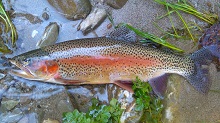The Abominable Snowman
Canadian Angling.com (October 21, 2013) Normally we don’t write articles about legends, myths, rumors, stories, etc, but since there is now some scientific research about the Abominable Snowman (Yeti), we decided to discuss their findings. For eons, the natives of the Himalaya Mountains have discussed an apelike species that lives there. Was it a legend or myth, no one knew until Bryan Sykes, a professor of genetic at Oxford did some research.
“I put out a call for Yeti, Bigfoot, and Sasquatch hairs in 2012, and I received a good response from all over the world,” Sykes said
The samples he had received were 2 hairs from one location in the Himalaya Mountains and the second was a jawbone that was discovered in the 1970’s from the opposite end. He then took the results and compared them to his database which included thousands of know animals. He took samples he had received and sequenced their DNA and was shocked by his results.
The DNA results suggest that this is some unknown bear species, and it is related to an extinct polar bear. Analysis of samples associated with claimed yetis found DNA that matched a sample from an ancient polar bear jawbone found in Norway that dates back to between 40,000 and 120,000 years ago.
He said “This is a species that hasn’t been recorded for 40,000 years. Now, we know one of these was walking around ten years ago. And what’s interesting is that we have found this type of animal at both ends of the Himalayas. If one were to go back, there would be others still there,” It could be a hybrid from the extinct polar bear and a brown bear. Many of the visual accounts are from mountaineers and hunters and they said that the animal acts strangely.
He went on to say “The fact that the hunter, who had great experience of bears, thought this one was in some way unusual and was frightened of it, makes me wonder if this species of bear might behave differently. Maybe it is more aggressive, more dangerous or is more bipedal than other bears,” he said.
This is an interesting discovery, but further research will be required and capturing a complete specimen would greatly advance research in this area and may lead to explanation of other species like this, including Bigfoot in North America.
Wayne Sheridan for Canadian Angling.com



